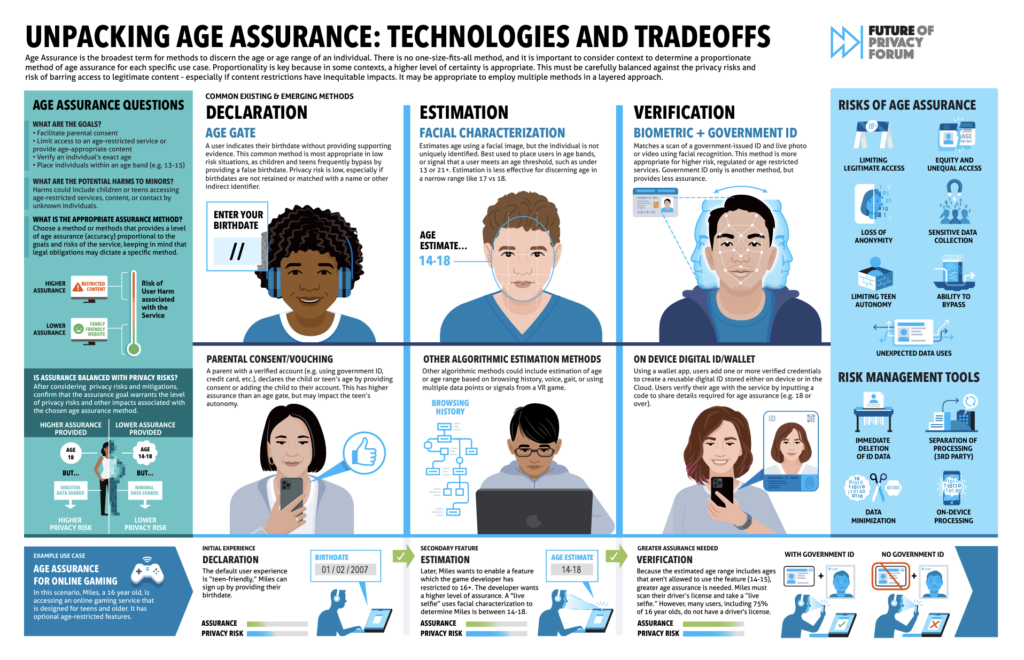New FPF Infographic Analyzes Age Assurance Technology & Privacy Tradeoffs
As a growing number of federal and state children’s online privacy and safety proposals seek to age-restrict social media and other online experiences, FPF released a new infographic, Unpacking Age Assurance: Technologies and Tradeoffs. The infographic analyzes the risks and potential harms associated with attempting to discern someone’s age online, as well as potential mitigation tools. FPF also outlines the privacy and accuracy tradeoffs of specific age assurance methods and technologies.
Click here to view the infographic.
“Age assurance is highly contextual, and the most privacy-protective approach requires choosing a method, or sometimes multiple methods, in a layered approach, that is proportional to the risks of each specific use case,” said Jim Siegl, FPF Youth & Education Senior Technologist, and a co-author of the infographic. “If the potential for user harm associated with the service is high, a higher level of certainty may be appropriate. We hope this analysis and visualization of the key decision points will serve as a helpful guide as policymakers, regulators, service providers, and others continue to evaluate options and potential solutions.”
The analysis outlines the three categories of age assurance, finding that:
- Age declaration, including age gate and parental consent/vouching, generally offers the lowest degree of privacy risks to the user and the lowest level of accuracy to the service provider. Parental consent provides more assurance than age-gating but may impact a teen’s autonomy.
- Age estimation, such as facial characterization and other algorithmic estimation methods based on browsing history, voice, gait, or data points/signals from a VR game, can be particularly effective for determining if a user meets an age threshold (e.g., under 13 or 21+) but is less accurate within in narrow age ranges (e.g., determining if a user is 17 or 18).
- Age verification, such as government ID plus biometrics or digital ID, is more appropriate for higher-risk, regulated, or age-restricted services, and it provides the greatest level of assurance but also poses the highest degree of privacy risks.
Balancing the privacy and equity implications of age assurance with the potential for harm to minors is an ongoing challenge for policymakers and online service providers. The infographic highlights some of those risks, including limiting legitimate access to online content, a loss of anonymity, limiting teen autonomy, and sensitive data collection and/or unexpected data uses. FPF also identifies some risk management tools, including on-device processing, data minimization, immediate deletion of ID data, and using a third party to separate data processing so that one company doesn’t control/access all of the data.
“Age assurance impacts all users on a service, not just minors. In addition to considering the tradeoffs around privacy and the potential for harm with each particular method, it’s important to balance those against the risk of barring access to content – especially if content restrictions have inequitable impacts,” said Bailey Sanchez, FPF Youth & Education Privacy Senior Counsel and a co-author of the infographic. “While age restrictions such as gambling are a matter of law, risk of harm is subjective – and that’s where things are starting to become really difficult. Different people make different calculations about potential risks posed by online gaming, for example.”
Unpacking Age Assurance builds on a series of new federal and state policy resources from FPF’s Youth & Education Privacy team. FPF recently released a report on verifiable parental consent, a form of age declaration and requirement of the Children’s Online Privacy Protection Act, and its analyses of new children’s privacy laws in Utah, California, Florida, and Connecticut highlight their respective approaches to age assurance.

To access the Youth & Ed team’s child and student privacy resources, visit www.StudentPrivacyCompass.org and follow the team on Twitter at @SPrivacyCompass.



